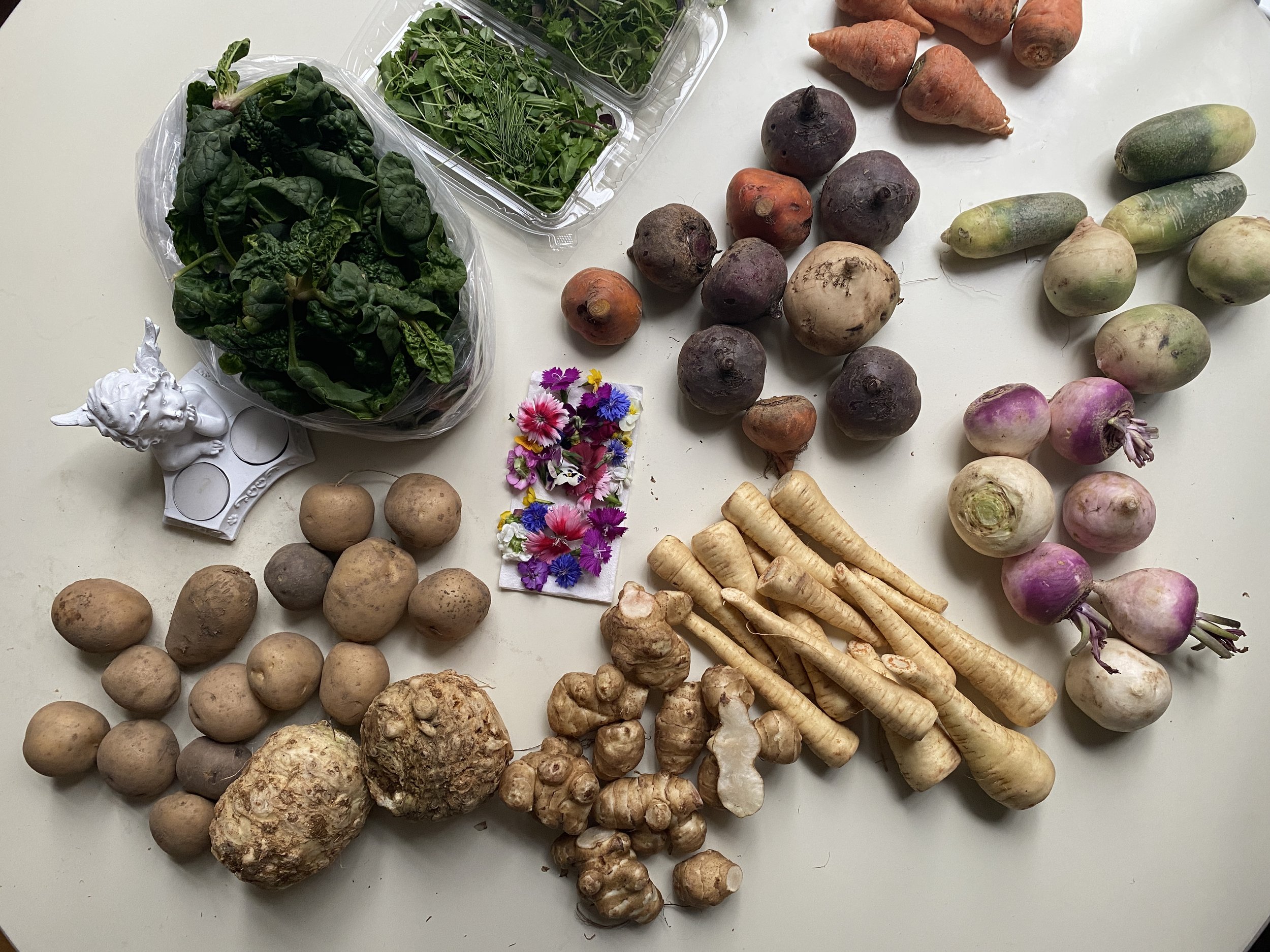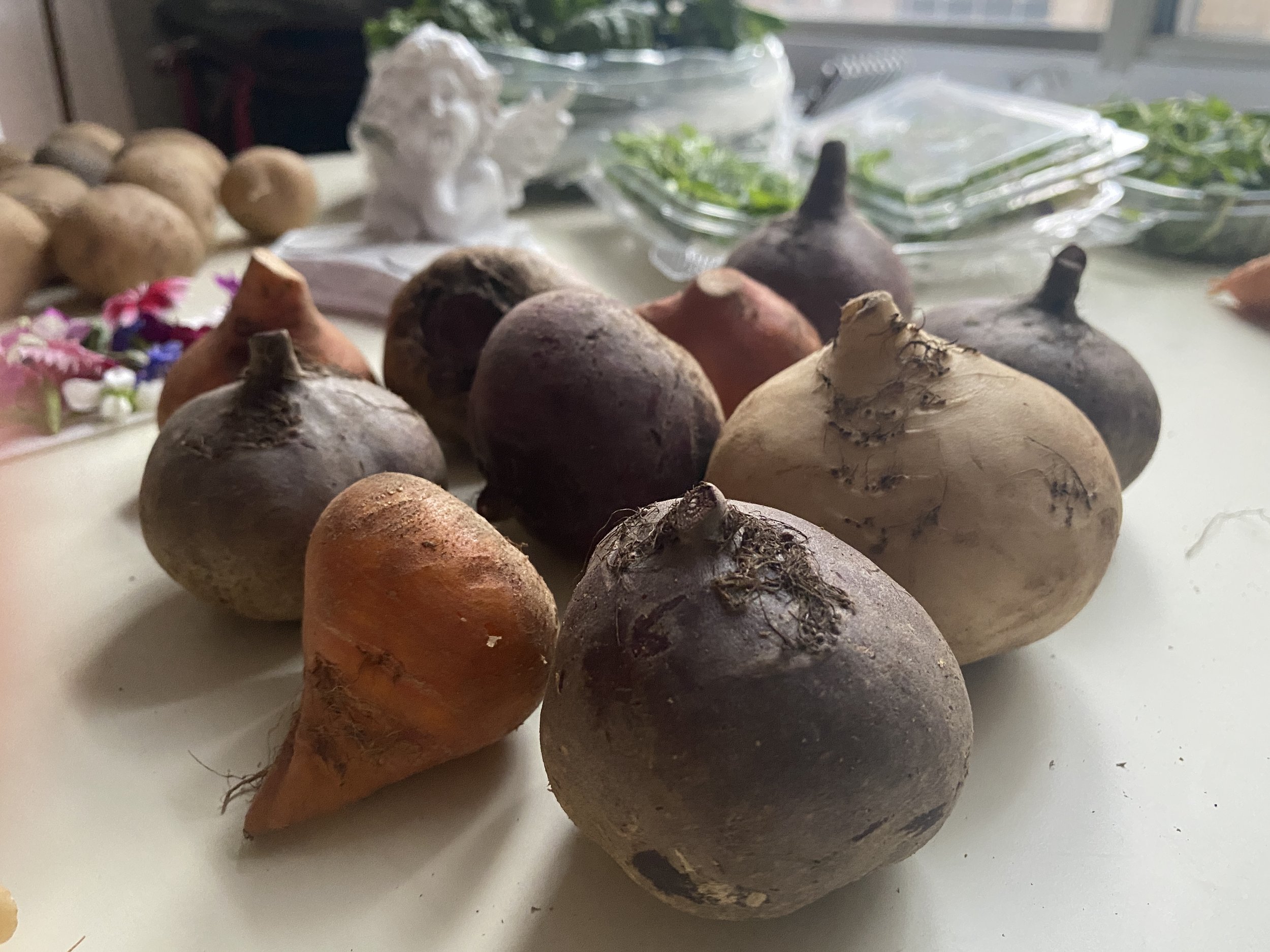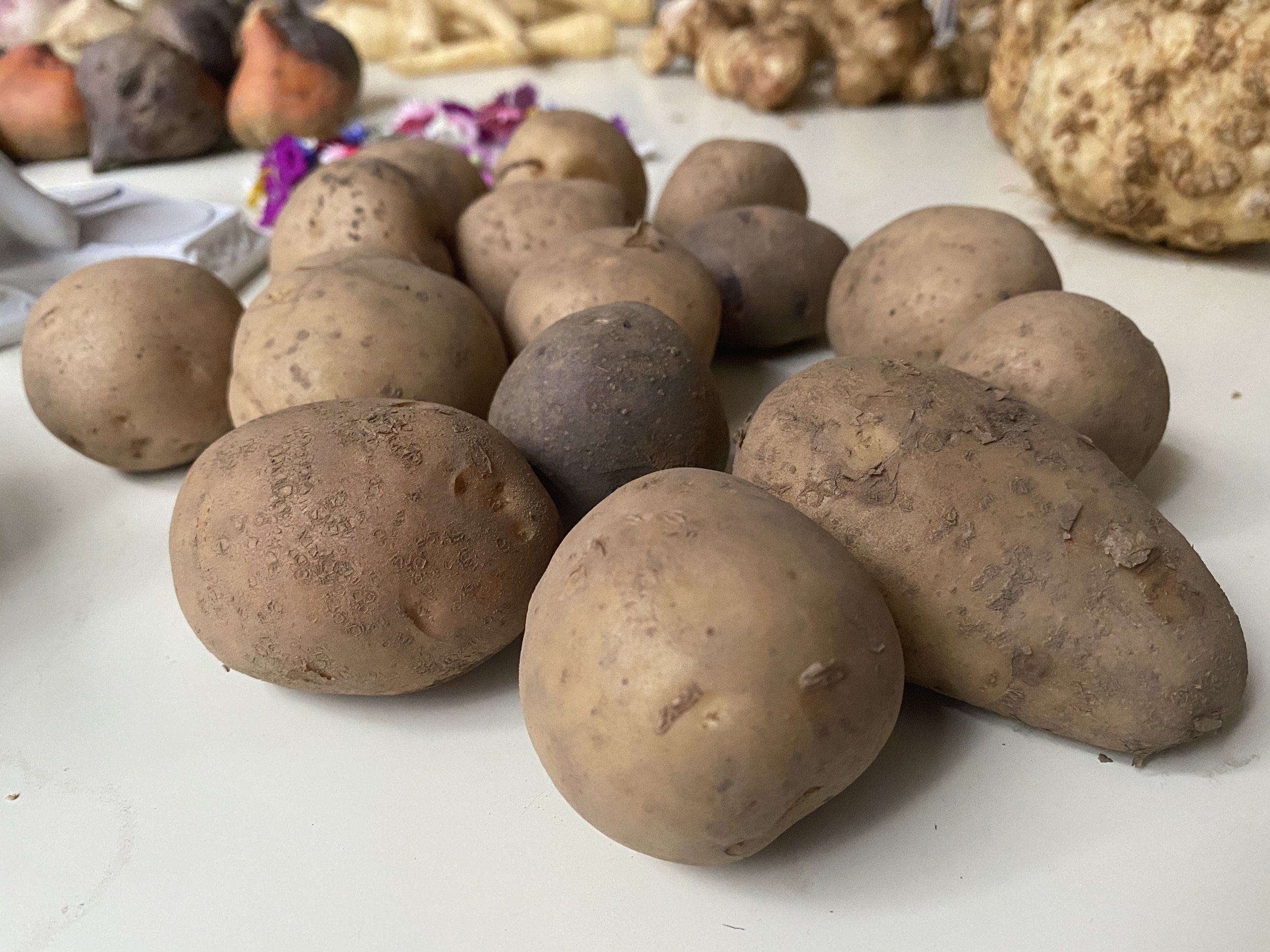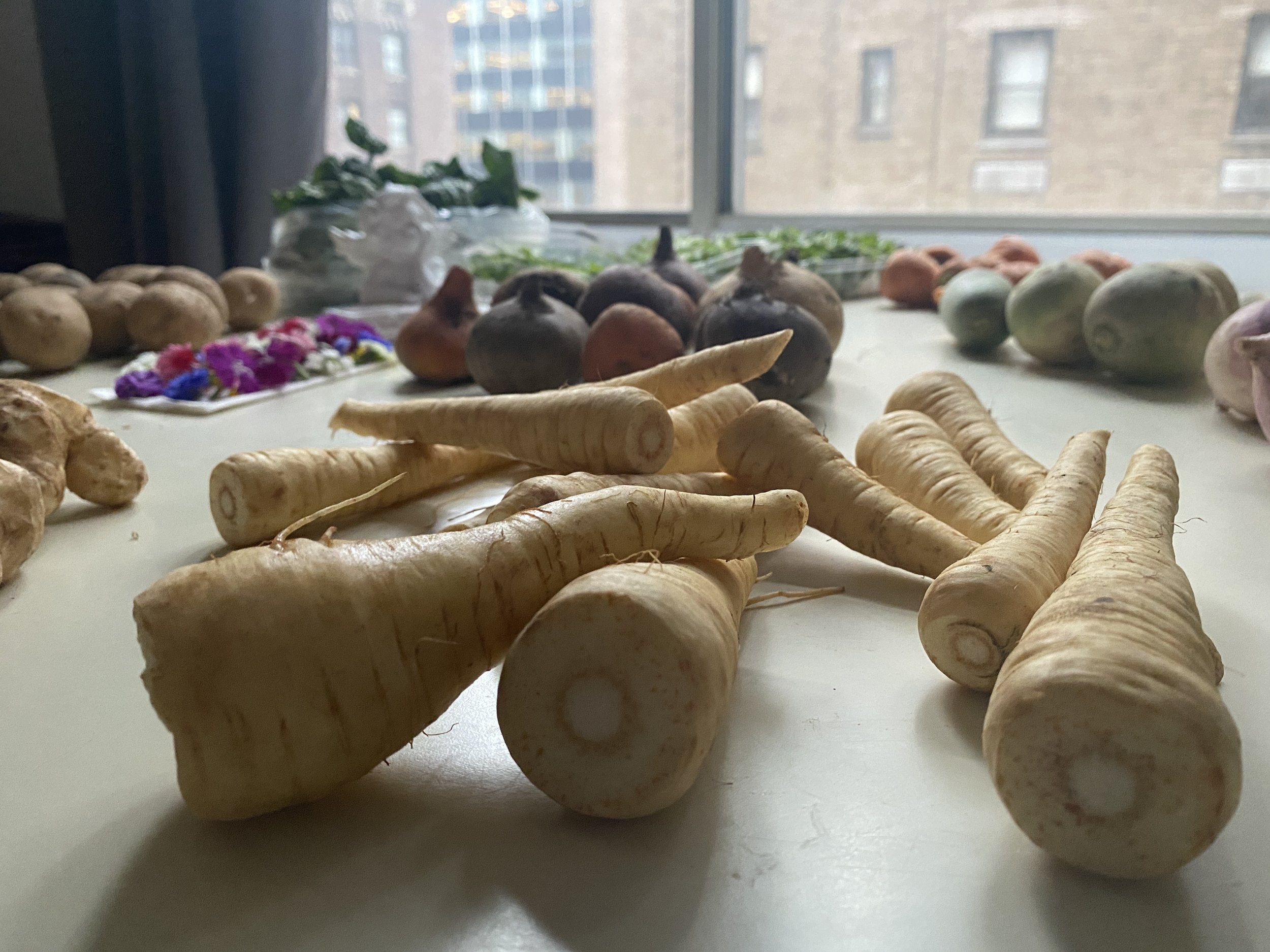East Meets West: Chinese Flavors with a U.S. Vegetable Box
The aim of this experiment is to incorporate a Ohio vegetable farm-share box in my Chinese, omnivore cooking repertoire. I have created 8 dishes that use the vegetables below, while still achieving a “Chinese” flavor profile that is familiar to my palate - which makes me more likely to cook these dishes on a day-to-day basis.
Why this experiment?
Accessibility. I have always been aware that it is not quite convenient to get authentic Chinese vegetables all the time for my cooking. Although it’s within 30-40 minutes single-way by the subway, Chinese groceries stores require a special trip from where I live.
Eating more locally. Eating locally grown vegetables not only reduce emissions from transportation, but the vegetables also tend to suffer less nutrition loss due to long transport times. Furthermore, for vegetables that are not sold locally via farmer’s markets or CSA/farm-share programs, there is a common practice of picking the vegetables weeks before peak ripeness to prevent rotting, in anticipation of the long transport times. As you can imagine, slightly under-ripe food would not taste as good as their naturally ripened counterparts.
I recognize that Ohio is still some distance from New York & that I could further improve this by subscribing to an even more local farm-share. Unfortunately, of the New York-based farm shares that were open at the time, 1) they did not allow someone to try out 1 box (which I wanted to do before deciding) - you have to subscribe for whole/half-seasons and 2) most were made for 2-4 people, so there would be a lot of food waste as I am only cooking for one. I will certainly keep looking.
I want to venture outside my comfort zone. I often stick with the vegetables that I am already familiar with eating from growing up.
What even is a farm-share box & how does it work?
The major difference between a farm-share box vs a “standard” grocery subscription service is that the FARMER (not me, not the consumers) gets to choose what kinds of vegetables they put in the box. This is a response to the reality that the vegetables we popularly deem as more desirable, like tomatoes, tend to be the ones that extract away a lot of energy from the soil; meanwhile, less popular plants like beans tend to be the plants that put nitrogen back to the soil and restores our ecosystem to balance. For a farmer to not deplete the soil, it is only sustainable that they plant a combination of both these kinds of vegetables AND have a customer base that is willing to buy both.
Hence a farm share box is born. When consumers give the choice back to farmers as to what vegetables to plant & eat, this allows farmers to not have to worry about not being able to sell the “less popular” vegetables that are more environmentally sustainable to grow.
This means that I have no say in what vegetables I get. Although the website did give a list of vegetables to expect for that week, I learned through reality that you really have no idea what you’re getting until your box arrives… which is exciting and scary.
The Unknown Ingredient List: Expectations vs. Reality
Expected & Received:
Carrots
Potatoes
Turnips
Beets
Spinach
Different:
Artichokes (green, herbaceous) —> Jerusalem Artichokes (starchy, neutral flavor when cooked)
Red Round Radish (which tastes mild & sweet) —> Lime Radish (which tastes highly spicy, acidic, and bitter)
? :
Kohlrabi ?? — Expected but missing
Celery Roots — Uninvited guest #1
Parsnips — Uninvited guest #2
Look, some of these vegetables (e.g. potatoes, carrots, spinach) are no strangers to Chinese cuisine. But for the rest, a little creativity was required…
Interlude
For the entire week before the vegetable box arrived, I was meticulously planning the exact Chinese recipes I would make from the exact list of expected ingredients on the website, which I wanted to cook within 7 days for them to maintain freshness. I had also ordered and bought the exact ingredients I planned to pair with these vegetables.
Imagine my sheer panic when 4 out of 9 ingredients I received were different from my expectation. To my surprise, this spiral pushed me to get hyper-focused and come up with an alternative game plan.
“Perhaps, creativity is not a product of abundance; rather, it is a product of healthy panic that arise from problem solving under novel constraints.”
Approach & Process
For each vegetable, I began by thinking about its quality - flavor, scent, texture under different cooking methods. Those qualities determine the function that the vegetable plays in the dish (for example, a neutral starch would be a texture addition, while an aromatic radish would act more as a raw salad/flavor garnish). I then thought of some classic Chinese dishes that requires the said functions, and placed those farm-share veggies in those roles.
Since I am using some non-traditional ingredients, the focus isn’t on 100% authenticity. Instead, it is on how creativity can transform any ingredient to fit a particular cuisine & its set of principles — in this case, Chinese food.
If you were to make a feast, here would be an order of the repertoire, from appetizer to dessert, with the following as the “star vegetable” of each dish:
Appetizers
1. Spinach: “Open Sesame” Salad 凉拌菠菜
2. Jerusalem Artichoke: Stewed in a Soup with Hen 洋姜炖鸡汤
3. Beets: Wrap with Beijing-Sauce 京酱肉丝卷
Entrees
4. Celeriac: Sauteed with Shrimp 芹菜(根)炒虾仁
5. Radish & Turnip: LanZhou Noodle Soup 兰州拉面
6. Carrot & Turnip: Lamb Stew 羊肉炖双萝
7. Potato: Slipped into Vinegar 醋溜土豆丝
Concluding Bites
8. Parsnip & Turnip: Savory Pudding 萝卜糕
[Bonus] “Sweet Water” of Well-Being 养生糖水
Spinach: “Open Sesame Salad”
Jerusalem Artichokes
Beets: Pork Wrap in Beijing Sauce
Celery Roots: Sauteed with Shrimp
Lime Radishes & Turnips: LanZhou-Style Beef Noodle Soup
Carrots & Turnips: Hearty Beef Stew
Potatoes: Slipped into Vinegar
[Youtube Short on How to Cook This]
Parsnips (& Turnips)
[Bonus] Jerusalem Artichokes: “Sweet Water” of Well-Being
This “sweet water” dessert is what Chinese medicine believes to be nourishing to your body and spirit, filled with classic well-being-boosting ingredients like dried dates, dried lily, and pear. If you are interested in how Chinese medicine views food to heal & nourish the body, stay tuned for my upcoming articles in the “Experiments & Concepts” section of the blog.






















